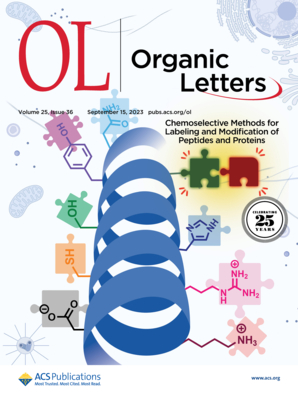三氟乙酸在杂芳烃微硅基化反应中的应用。
IF 5
1区 化学
Q1 CHEMISTRY, ORGANIC
引用次数: 0
摘要
首次实现了以三氟乙酸为氢原子转移试剂,以CF3自由基激活Si-H键的光诱导Minisci反应。这种方法可以合成各种硅基化的缺电子杂芳烃,收率中至高。进行了机理研究,为反应过程提供支持证据。该反应无金属,操作简单,反应条件温和。本文章由计算机程序翻译,如有差异,请以英文原文为准。

The Application of Trifluoroacetic Acid in the Minisci Silylation of Heteroarenes
A photoinduced Minisci reaction involving Si–H bond activation via a CF3 radical generated from trifluoroacetic acid as a hydrogen atom transfer reagent has been achieved for the first time. This approach enables the synthesis of a diverse array of silylated electron-deficient heteroarenes in moderate to high yields. Mechanistic studies were conducted to provide supporting evidence for the reaction process. The reaction features a metal-free protocol, operational simplicity, and compatibility with mild reaction conditions.
求助全文
通过发布文献求助,成功后即可免费获取论文全文。
去求助
来源期刊

Organic Letters
化学-有机化学
CiteScore
9.30
自引率
11.50%
发文量
1607
审稿时长
1.5 months
期刊介绍:
Organic Letters invites original reports of fundamental research in all branches of the theory and practice of organic, physical organic, organometallic,medicinal, and bioorganic chemistry. Organic Letters provides rapid disclosure of the key elements of significant studies that are of interest to a large portion of the organic community. In selecting manuscripts for publication, the Editors place emphasis on the originality, quality and wide interest of the work. Authors should provide enough background information to place the new disclosure in context and to justify the rapid publication format. Back-to-back Letters will be considered. Full details should be reserved for an Article, which should appear in due course.
 求助内容:
求助内容: 应助结果提醒方式:
应助结果提醒方式:


